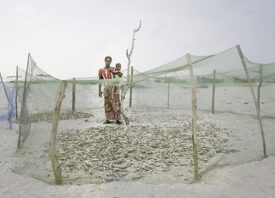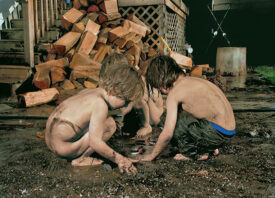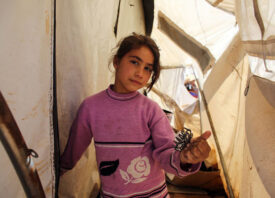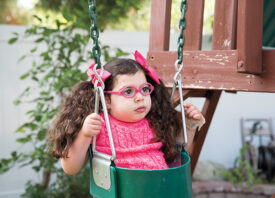Search this site
‘Living on a Dollar a Day’ Captures the Silenced Minority on Poverty’s Edge
Starvation: In the Charan slum settlement of northern India, Kalpana, 20, starves one of her children Sangeeta, 2, while her sister Sarita, 5-months-old, right, sleeps in comfort, above right, in her mother’s arms. Sangeeta only weighs 9 pounds. Children are more likely to appeal to the sympathy of those inclined to give to beggars, so those who beg use children for this purpose. Worse, sometimes as in this case a child is starved and carried about by the child’s parent while she begs on the streets or rented out to another beggar to be used as an object of sympathy in the hope of generating more income over the course of a given day. Sometimes these extra funds are used to feed other children, thus, in practice; one child is sacrificed for the sake of others. Sangeeta has since been helped by the Tong-Len Charitable Trust’s mobile medical clinic at the Charan slum settlement, Dharamsala, India. But according to the World Bank 19,000 children die a day from preventable causes. © Renée C. Byer
Working to Survive: In an e-waste dump that kills nearly everything that it touches, Fati, 8, works with other children searching through hazardous waste in hopes of finding whatever she can to exchange for pennies in order to survive. While balancing a bucket on her head with the little metal she has found, tears stream down her face as the result of the pain that comes with the malaria she contracted some years ago. This is work she must do to survive.
Pulitzer-prize winning photographer, Renée C. Byer, has traveled to 10 countries spread over four continents in the past four years documenting the myriad lives lived on less than a dollar a day. The photographs, both harrowing and inspiring, are Byer’s way to span the ever-widening gap between the haves and the have-nots.
“Art is a powerful means of expression,” Byer said in an interview with National Geographic’s photography blog, Proof. “But combined with journalism it has the ability to bring awareness to issues that can elevate understanding and compassion.” The final product, Living on a Dollar a Day, was the brainchild of Tom Narario and The Forgotten International, a non-profit organization based in California, which works to alleviate poverty both in the United States and internationally.
In that same interview, Byer discusses the challenge of moving beyond photographic cliché and the struggle to create an experience that would hold the viewers’ attention.
“For me it’s very important to go behind the scenes and into [a subject’s] home to find pieces of daily life that everyone can relate to,” she said, adding: it is critical that the viewers “can imagine themselves trying to live this life, and in some way, hopefully, they could help.”
Byer, who won the 2007 Pulitzer prize for Feature Photography for her story about a single mother and her son who loses his battle with cancer, is no stranger to tackling subject of international import, but said working on this project demanded not only a resolve to honestly capture the daily implications of poverty, but also to channel the audience’s concern into meaningful action.
“Everyone thinks that [photojournalists] live in this glamorous world, and of course part of being a photojournalist is making the images,” Byer told National Geographic. “But I find that people don’t understand that the biggest challenge is getting the photos in the right forum to motivate change.”
Living on a Dollar a Day is available now, and Byer’s images are already making a difference. 8-year-old Fati, for instance, who was previously working in an e-waste dump in Ghana, is now being funded by someone who was touched by her portrait. Today, she is a student at a boarding school and has shoes to protect her feet, for the first time in her life. Additionally, two other girls have received aid because of Byer’s work. Byer is the first place recipient of the Best of Photojournalism awards by the National Press Photographer’s Association and she recently exhibited her photos at Viewpoint Gallery, and she plans on showing the work in a series of traveling exhibitions in venues at schools around the world. She is currently looking for host venues.
The images in this post are COPYRIGHT ©RENÉE C. BYER from the book Living On A Dollar A Day: The Lives and Faces of the Poor (The Quantuck Lane Press, 2014) by Thomas A. Nazario, with Photographs by Renée C. Byer, Foreword by the 14th Dalai Lama.

Disabled but Still Working: Jestina Koko, 25, with her daughter Satta Quaye, 5. Crippled since the age of three, she depends on her arms to lift and drag herself. She survives by doing laundry for others, selling cookies on the street, and begging in Monrovia, Liberia. Both of them suffer from malaria. She wishes for a wheel chair, a private room to live in and for her daughter to go to school. They sleep in the hallway of a home that has no electric, toilet or running water and own nothing. © Renée C. Byer

The Cycle Continues: Labone, 27, takes a moment to hold her young daughter Nupur, 1, who was fathered by a client, before she has to return to her evening’s work in a brothel in Jessore, Bangladesh. Most children born into the sex trade follow the same cycle of abuse as their mothers. With more than half it’s population living below the poverty line, Bangladesh remains one of the poorest countries in the world. As in other countries, poverty, low social status, and lack of opportunities for education and employment have forced women to become sex workers. Many girls are sold by their families into the sex trade for very little money. © Renée C. Byer

Hoping for a Miracle: Four-year-old Ana-Maria Tudor, above, stands in the light of her doorway in Bucharest, Romania, hoping for a miracle as her family faces eviction from the only home they have ever had. Her father recently had a gall bladder surgery that resulted in an infection and left him unable to work. The one room they live in has no bathroom or running water. © Renée C. Byer

Land Mine Victim Faces Eviction: Phay Phanna, 60, lost his leg when he stepped on a land mine in 1988 near the Cambodian-Thai border. He is a widower and is the sole head of his family, caring for 11 children in a home he does not own. It has been scheduled for demolition since being purchased by a private developer in 2008 in Phnom Penh, Cambodia. © Renée C. Byer

Blind Beggar: A sea of people passes by Hunupa Begum, 13, who has been blind for the past 10 years and lives close to the Nizamudin Bangala Masjid (Mosque) in New Delhi, India. She begs as the only source of income for her family that consist of a brother Hajimudin Sheikh, 6, center, who suffers fluids that accumulate in his head and her mother Manora Begum, 35, right, who suffers from Asthma, and she has a womb ailment and can’t do manual labor. Their father Nizam Ali Sheikh died ten years ago of Tuberculosis. Her wheelchair was donated by a passerby. © Renée C. Byer

Tall Grasses: The boys of the Gamfu family Ninankor Gmafu, 6, and Tibetob Gmafu, 5, carry their machetes as they go off to their day’s work of caring for some forty cows that roam about the property that they are required to watch over in northern Ghana. © Renée C. Byer

Child Herder in Bolivia: Following the death of his father, Alvaro Kalancha Quispe, 9, helps his family survive by herding. He opens the gate to the stone pen that holds the family’s alpacas and llamas each morning so they can graze throughout the hillsides during the day. He then heads off to school, but must round them up again in the evening in the Akamani mountain range of Bolivia in an area called Caluyo, about an hour from the city of Qutapampa. In this part of the world, the highlands of Bolivia, approximately 13,000 feet above sea level, residents live in homes with no insulation, no electricity, and no beds. Their water comes from streams that run off the snow-covered mountains. Their livelihood lies with their animals, for each animal produces about three pounds of fur each year, and each pound of fur is sold for 18 bolivianos, which amounts to about $2.50 U.S. All in all, this family may earn about $200 of income each year from the herd they watch over. © Renée C. Byer





